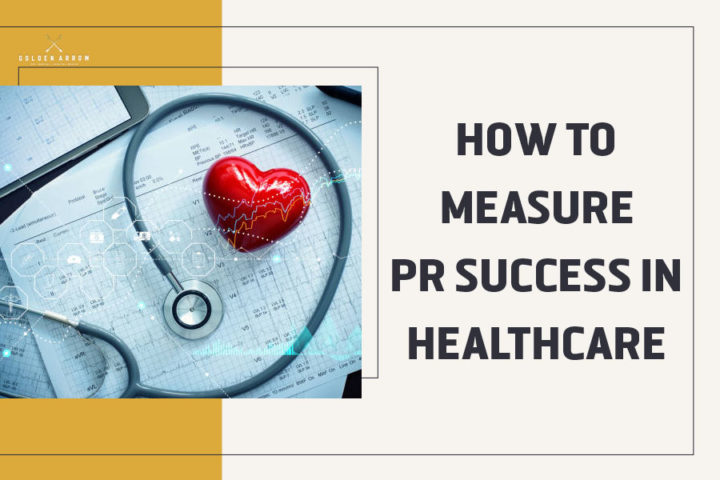Evaluating the effectiveness of PR for healthcare facilities is just as important as the campaign itself. You must learn how to measure PR success in healthcare to see significant results.
Assessing PR outcomes in the healthcare industry will help you bring your services closer to the target group and gain their trust. So, there are multiple ways to measure PR success.
With our help, you will know the ways to get your hands on those metrics and discover how to use them to increase your brand exposure and client engagement.
How to Measure PR Success in Healthcare
Measuring public relations success in the healthcare sector is important because it validates PR efforts. With every measurement of the PR campaign, you will get valuable insights about its effectiveness and the need for adjustments.
Here are the best ways how to measure PR success in healthcare.
Define clear objectives
The first step to a successful PR strategy is to set up SMART objectives. As a Healthcare PR Agency, each of the objectives we will set for your facility will be:
- Specific
- Measurable
- Achievable
- Relevant
- Time-bound
Setting up SMART objectives, in the beginning, makes assessing PR outcomes in the healthcare industry easier and more convenient and helps build a potentially successful PR strategy. Formulating the PR strategy goals is vital because it creates a clearer focus and will allow effective use of resources and time.
Every SMART objective of the PR campaign should work towards achieving the broader organizational goals. The PR objectives must align with the organization’s mission, vision, and goals.
Generally, the SMART goals focus on three things. The first one is educating the patients and encouraging engagement. Next, the objectives should build brand awareness and manage the facility’s reputation. Lastly, the goals should promote community standards and give patients a sense of belonging.
Measuring PR success in healthcare with SMART objectives is one of the most convenient ways to assess the PR campaign. Use the results during and at the end of the PR campaign and see whether they are leading the organization toward achieving the SMART objectives.

Key performance indicators (KPIs) for healthcare PR
Key performance indicators, or KPIs, are performance measures for healthcare PR. The KPIs are used for monitoring, analyzing, and optimizing the organizational processes to increase overall satisfaction.
The KPIs are not just focused on the experience patients have with your healthcare facility. In fact, they also include the satisfactory rates of healthcare providers.
We use the KPIs as metrics when we want to compare the performance of your healthcare facility with the competitors. Typically, the different types of KPIs tell us in which areas your work can improve so that we can build a suitable PR strategy.
Different KPIs reflect the aspects of PR impact, and they include:
- Strategic– might include return on investment, market share, and revenue.
- Operational– include the number of patients and operations.
- Functional units– typically for specific functions inside the healthcare facility, like finance.
- Leading KPIs– focused on predicting possible outcomes.
- Lagging KPIs– metrics for things that have already happened.
Media coverage and visibility
The media coverage and visibility of the healthcare facility are a crucial part of the PR strategy. However, the high volume of media coverage isn’t the only thing important concerning PR. In fact, the message you are trying to send should reach the target audience.
Considering this, measuring public relations success in the healthcare sector can be done by analyzing the quality and quantity of media coverage. You can measure the success of media coverage in multiple ways.
Some of the best tools to measure media coverage for printed and online mediums are:
- Google Alerts
- Talkwalker Alerts
- Readly
- PressReader
- Prowly
- Mention
- Muck Rack
Press clippings
First, measuring the number of press clippings mentioning the healthcare facility is important. A successful PR program should aim to have as many mentions in target media outlets as possible.
Circulation
In addition to the press clippings, checking the number of media impressions is beneficial.
Another way how to measure PR success in healthcare is by multiplying the number of press clippings and the total circulation. The higher the number, the more successful the PR campaign.
Content quality
Next, the quality of the content published during the PR campaign should be monitored. High-quality articles, interviews, and press releases will increase brand exposure and might result in higher patient flow.
Visibility
Regarding the visibility of the healthcare facility, it might be a good idea to launch a market survey before and after implementing the PR strategy. The survey gives excellent insights into how many people have heard about your healthcare services.
Social media engagement
In a digital era, every PR program must include social media platforms, and both need to be aligned. Hence, evaluating PR effectiveness in healthcare should also include social media.
You will measure your target audience’s engagement by tracking the social media metrics. The advantage of using social media is that you can target individuals and potential business partners.
As a healthcare institution, you have multiple social media tools, including social networking and media-sharing sites. The most common uses for social media in healthcare are:
- Professional networking
- Professional education
- Organizational promotion
- Patient care
- Patient education
- Participation in public health programs
Using social media makes your healthcare facility more approachable, which positively influences the PR success measurement. Social media posts are an excellent way to promote awareness and share accurate health messages while benefiting from brand exposure.
The audience engages on social media using different features, including likes, shares, and comments. This is important for the PR campaign because it can easily distinguish the content the audience likes from the one they are not interested in.
By finding and analyzing the engagement patterns of the audience, the PR strategy can be adjusted. That way, with a more audience-driven PR program, achieving the organization’s objectives will be easier.

Website traffic and online presence
Analyzing the website traffic is another important way how to measure PR success in healthcare. Having a website for your healthcare facility has a lot of benefits that positively influence PR success.
- A well-tailored website makes your business credible in the patient’s eyes who are hearing of you for the first time.
- The website allows your potential patients to learn more about your services 24/7.
- An easy-to-use interface with different features can make patients choose your facility over the competitors.
Website analytics give you in-depth information about visitors’ activity and behavior. PR can have an impact on a lot of aspects of website traffic. Some of the most important are:
- Information about web users
- Goal conversions
- Session duration and bounce rates
- Engagement rates
- Traffic origins
- Page views
Thought leadership and industry influence
With thought leadership, the healthcare facility can show expertise to the target audience. Consequently, it is considered a PR success measurement. Developing thought leaders is challenging in the healthcare industry, but it is possible with the right PR program.
Through thought leadership, your healthcare facility can increase brand exposure and build trust among the target group by showing industry, service, and organizational expertise.
A baseline should be established for measuring PR success in healthcare, and the leader’s appearance should be monitored. One of the best ways to track the effectiveness of the PR plan is to count the number of shares and mentions of the thought leader.
Positioning healthcare professionals as industry experts contributes to brand authority and credibility. Some of the trackable factors influencing brand authority are audience opinion, general sentiment, and responses to issues or crises.
If the trust in the healthcare facility increases the mentions of thought leaders, it brings higher positive engagement with the content, higher search volume, and more.
Measuring PR ROI
The return on investment from PR is divided into monetary and media gains. As with every type of investment, the monetary gains include an increase in sales revenue.
One of the biggest mistakes we see as a PR agency is that the clients only focus on the monetary gains. However, the earned media gains are equally important and include the credibility and reputation of the healthcare facility.
While monetary gains can be short-term and inconsistent, earned media gain as a category of ROI brings long-term benefits.
To measure the PR ROI in healthcare, it is best to use different methods, including:
- Quantitative metrics
- Qualitative metrics
- Comparative metrics
- Assessing the value
- Quantification of ROI
Regular reporting and analysis
Whichever method you choose on how to measure PR success in healthcare, it is significantly important to do frequent monitoring, reporting, and analysis activities.
With the results from the analysis, we have a clear picture of whether the PR campaign is headed in the right direction. We can find ways to improve the strategy according to the data we gather.
Source: unsplash.com
Long-term vs. short-term metrics
We tend to balance short- and long-term PR metrics when evaluating PR effectiveness in healthcare. That way, we have a comprehensive view of the PR success.
The short-term metrics include:
- Media mentions
- Social media engagement
- Website traffic
- Event attendance
- Press release distribution
- Social media followers
On the other hand, long-term metrics are:
- Brand perception
- Brand recognition
- Share of voice
- Conversation rates
- Website SEO
- Thought leadership
- Crisis preparedness
- Long-term reputation
- Customer loyalty
- Shareholder perception

Conclusion
Effective measurement and using different strategies and metrics will improve the PR strategy according to the market and client needs.
By knowing how to measure PR success in healthcare, you are one step closer to increasing brand awareness and credibility and bringing your services closer to your potential patients.


